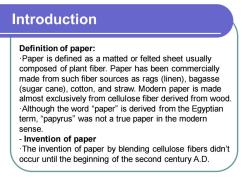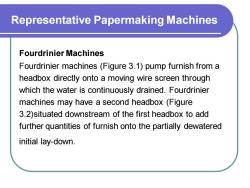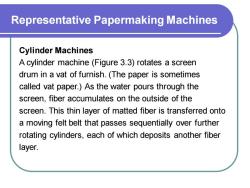陕西科技大学:《包装技术基础 Fundamentals of Packaging Technology》课程PPT教学课件(英文版)Lesson 3 Paper and Paperboard 第3课 纸与纸板

UNIT TWO PACKAGING MATERIALS AND CONTAINER 第二单元 包装材料和容器
UNIT TWO PACKAGING MATERIALS AND CONTAINER 第二单元 包装材料和容器

Lesson 3 Paper and Paperboard 第3课 纸与纸板
Lesson 3 Paper and Paperboard 第3课 纸与纸板

Introduction Definition of paper: ·Paper is defined as a matted or felted sheet usually composed of plant fiber. Paper has been commercially made from such fiber sources as rags (linen), bagasse (sugar cane), cotton, and straw. Modern paper is made almost exclusively from cellulose fiber derived from wood. ·Although the word “paper” is derived from the Egyptian term, “papyrus” was not a true paper in the modern sense. - Invention of paper ·The invention of paper by blending cellulose fibers didn’t occur until the beginning of the second century A.D
Introduction Definition of paper: ·Paper is defined as a matted or felted sheet usually composed of plant fiber. Paper has been commercially made from such fiber sources as rags (linen), bagasse (sugar cane), cotton, and straw. Modern paper is made almost exclusively from cellulose fiber derived from wood. ·Although the word “paper” is derived from the Egyptian term, “papyrus” was not a true paper in the modern sense. - Invention of paper ·The invention of paper by blending cellulose fibers didn’t occur until the beginning of the second century A.D

Introduction Ts’ai Lun, a member of the court of the later Han Dynasty, is generally credited with developing the first real papermaking process in 105 A.D. ·The “Fourdrinier machine” was the first on the market and produced a homogenous (single-ply) sheet of boxboard in various thicknesses. It was soon joined by the “Cylinder machine” which formed a multi-layered (multi-ply) type of paperboard. These machines were first installed in the United States around 1830
Introduction Ts’ai Lun, a member of the court of the later Han Dynasty, is generally credited with developing the first real papermaking process in 105 A.D. ·The “Fourdrinier machine” was the first on the market and produced a homogenous (single-ply) sheet of boxboard in various thicknesses. It was soon joined by the “Cylinder machine” which formed a multi-layered (multi-ply) type of paperboard. These machines were first installed in the United States around 1830

Introduction Paper and paperboard · Paperboard, boxboard, cardboard, and cartonboard are all terms used to describe heavier paper stock. · The International Organization for Standardization (ISO) states that material weighing more than 250 grams per square metre (511b per 1,000 sq. ft.) shall be known as paperboard. U.S. practice calls material that is more than 300(0.012 in.) thick paperboard
Introduction Paper and paperboard · Paperboard, boxboard, cardboard, and cartonboard are all terms used to describe heavier paper stock. · The International Organization for Standardization (ISO) states that material weighing more than 250 grams per square metre (511b per 1,000 sq. ft.) shall be known as paperboard. U.S. practice calls material that is more than 300(0.012 in.) thick paperboard

Representative Papermaking Machines Fourdrinier Machines Fourdrinier machines (Figure 3.1) pump furnish from a headbox directly onto a moving wire screen through which the water is continuously drained. Fourdrinier machines may have a second headbox (Figure 3.2)situated downstream of the first headbox to add further quantities of furnish onto the partially dewatered initial lay-down
Representative Papermaking Machines Fourdrinier Machines Fourdrinier machines (Figure 3.1) pump furnish from a headbox directly onto a moving wire screen through which the water is continuously drained. Fourdrinier machines may have a second headbox (Figure 3.2)situated downstream of the first headbox to add further quantities of furnish onto the partially dewatered initial lay-down

Representative Papermaking Machines Figure 3.1 Furnish pours out of the headbox of a fourdrinier machine and onto an endless wire or screen where excess water can be drained. The fibers remain trapped on the screen
Representative Papermaking Machines Figure 3.1 Furnish pours out of the headbox of a fourdrinier machine and onto an endless wire or screen where excess water can be drained. The fibers remain trapped on the screen

Representative Papermaking Machines Figure 3.2 Paper is dewatered at the wet end of a fourdrinier machine
Representative Papermaking Machines Figure 3.2 Paper is dewatered at the wet end of a fourdrinier machine

Representative Papermaking Machines Cylinder Machines A cylinder machine (Figure 3.3) rotates a screen drum in a vat of furnish. (The paper is sometimes called vat paper.) As the water pours through the screen, fiber accumulates on the outside of the screen. This thin layer of matted fiber is transferred onto a moving felt belt that passes sequentially over further rotating cylinders, each of which deposits another fiber layer
Representative Papermaking Machines Cylinder Machines A cylinder machine (Figure 3.3) rotates a screen drum in a vat of furnish. (The paper is sometimes called vat paper.) As the water pours through the screen, fiber accumulates on the outside of the screen. This thin layer of matted fiber is transferred onto a moving felt belt that passes sequentially over further rotating cylinders, each of which deposits another fiber layer

Representative Papermaking Machines Figure 3.3 A single cylinder station on a cylinder-type machine
Representative Papermaking Machines Figure 3.3 A single cylinder station on a cylinder-type machine
按次数下载不扣除下载券;
注册用户24小时内重复下载只扣除一次;
顺序:VIP每日次数-->可用次数-->下载券;
- 陕西科技大学:《包装技术基础 Fundamentals of Packaging Technology》课程PPT教学课件(英文版)Lesson 2 Packaging Functions 第2课 包装的功能.ppt
- 陕西科技大学:《包装技术基础 Fundamentals of Packaging Technology》课程PPT教学课件(英文版)Lesson 20 Filling Systems 第20课 充填灌装系统.ppt
- 陕西科技大学:《包装技术基础 Fundamentals of Packaging Technology》课程PPT教学课件(英文版)Lesson 1 A History of Packaging 第1课 包装发展史.ppt
- 陕西科技大学:《包装技术基础 Fundamentals of Packaging Technology》课程PPT教学课件(英文版)Lesson 19 The Packaging Line 第19课 包装线.ppt
- 陕西科技大学:《包装技术基础 Fundamentals of Packaging Technology》课程PPT教学课件(英文版)Lesson 18 General Overview 第18课 概述.ppt
- 陕西科技大学:《包装技术基础 Fundamentals of Packaging Technology》课程PPT教学课件(英文版)Lesson 17 Computer Aided Packaging System 第17课 计算辅助包装设计系统.ppt
- 陕西科技大学:《包装技术基础 Fundamentals of Packaging Technology》课程PPT教学课件(英文版)Lesson 16 Distribution Packaging 第16课 运输包装.ppt
- 陕西科技大学:《包装技术基础 Fundamentals of Packaging Technology》课程PPT教学课件(英文版)Lesson 15 Seven Steps for Cushioned Package Development 第15课 缓冲包装设计七步法.ppt
- 陕西科技大学:《包装技术基础 Fundamentals of Packaging Technology》课程PPT教学课件(英文版)Lesson 14 Test Method for Product Fragility 第14课 产品脆值试验方法.ppt
- 陕西科技大学:《包装技术基础 Fundamentals of Packaging Technology》课程PPT教学课件(英文版)Lesson 13 Mechanical Shock Theory 第13课 机械冲击理论.ppt
- 陕西科技大学:《包装技术基础 Fundamentals of Packaging Technology》课程PPT教学课件(英文版)Lesson 12 Shock, Vi ation, and Compression 第12课 冲击、振动和受压.ppt
- 陕西科技大学:《包装技术基础 Fundamentals of Packaging Technology》课程PPT教学课件(英文版)Lesson 11 Package Printing 第11课 包装印刷.ppt
- 陕西科技大学:《包装技术基础 Fundamentals of Packaging Technology》课程PPT教学课件(英文版)Lesson 10 Graphic Design in Packaging 第10课 包装中的平面设计.ppt
- 石河子大学:《工业工程基础》课程PPT教学课件(农机专业,2012)第8章 生产率.ppt
- 石河子大学:《工业工程基础》课程PPT教学课件(农机专业,2012)第4章 工作研究概述.ppt
- 石河子大学:《工业工程基础》课程PPT教学课件(农机专业,2012)现场管理.ppt
- 石河子大学:《工业工程基础》课程PPT教学课件(农机专业,2012)第一章 工业工程概述(1.1)工业工程的发展和作用(主讲人:张慧明).ppt
- 石河子大学:《工业工程基础》课程PPT教学课件(农机专业,2012)第一章 工业工程概述(1.2)工业工程定义和内容.ppt
- 石河子大学:《工业工程基础》课程PPT教学课件(农机专业,2012)预定时间标准及模特法.ppt
- 石河子大学:《工业工程基础》课程PPT教学课件(农机专业,2012)操作分析.ppt
- 陕西科技大学:《包装技术基础 Fundamentals of Packaging Technology》课程PPT教学课件(英文版)Lesson 4 Corrugated Fiberboard Boxes 第4课 瓦楞纸板箱.ppt
- 陕西科技大学:《包装技术基础 Fundamentals of Packaging Technology》课程PPT教学课件(英文版)Lesson 5 Metal Containers 第5课 金属容器.ppt
- 陕西科技大学:《包装技术基础 Fundamentals of Packaging Technology》课程PPT教学课件(英文版)Lesson 6 Glass Containers 第6课 玻璃容器.ppt
- 陕西科技大学:《包装技术基础 Fundamentals of Packaging Technology》课程PPT教学课件(英文版)Lesson 7 Plastics in Packaging 第7课 塑料在包装中的应用.ppt
- 陕西科技大学:《包装技术基础 Fundamentals of Packaging Technology》课程PPT教学课件(英文版)Lesson 8 Flexible Packaging Laminates 第8课 软包装复合材料.ppt
- 陕西科技大学:《包装技术基础 Fundamentals of Packaging Technology》课程PPT教学课件(英文版)Lesson 9 Color 第9课 颜色.ppt
- 沈阳师范大学:《通风除尘与物料输送》课程教学课件(PPT讲稿)流体力学基础 1.1 第一节 空气在管道中流动的基本规律.ppt
- 沈阳师范大学:《通风除尘与物料输送》课程教学课件(PPT讲稿)流体力学基础 1.2 第二节 流动阻力和能量损失.ppt
- 沈阳师范大学:《通风除尘与物料输送》课程教学课件(PPT讲稿)流体力学基础 1.3 第三节 管路中的压力、速度和流量的测量.ppt
- 沈阳师范大学:《通风除尘与物料输送》课程教学课件(PPT讲稿)风机 2.1 第一节 离心式通风机的构造和工作原理.ppt
- 沈阳师范大学:《通风除尘与物料输送》课程教学课件(PPT讲稿)风机 2.2 第二节 离心式通风机的性能参数.ppt
- 沈阳师范大学:《通风除尘与物料输送》课程教学课件(PPT讲稿)风机 2.3 第三节 离心式通风机的选择.ppt
- 沈阳师范大学:《通风除尘与物料输送》课程教学课件(PPT讲稿)风机 2.4 第四节 离心式通风机的安装与使用.ppt
- 沈阳师范大学:《通风除尘与物料输送》课程教学课件(PPT讲稿)通风除尘技术 3.1 第一节 粉尘.ppt
- 沈阳师范大学:《通风除尘与物料输送》课程教学课件(PPT讲稿)通风除尘技术 3.2 第二节 含尘浓度、卫生标准和排放标准.ppt
- 沈阳师范大学:《通风除尘与物料输送》课程教学课件(PPT讲稿)通风除尘技术 3.3 第三节 粮食厂仓控制粉尘的通风除尘.ppt
- 沈阳师范大学:《通风除尘与物料输送》课程教学课件(PPT讲稿)通风除尘技术 3.4 第四节 除尘器.ppt
- 沈阳师范大学:《通风除尘与物料输送》课程教学课件(PPT讲稿)通风除尘技术 3.5 第五节 通风除尘网络的设计与计算.ppt
- 沈阳师范大学:《通风除尘与物料输送》课程教学课件(PPT讲稿)通风除尘技术 4.1 气力输送技术A.ppt
- 沈阳师范大学:《通风除尘与物料输送》课程教学课件(PPT讲稿)通风除尘技术 4.2 气力输送技术B.ppt
